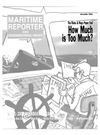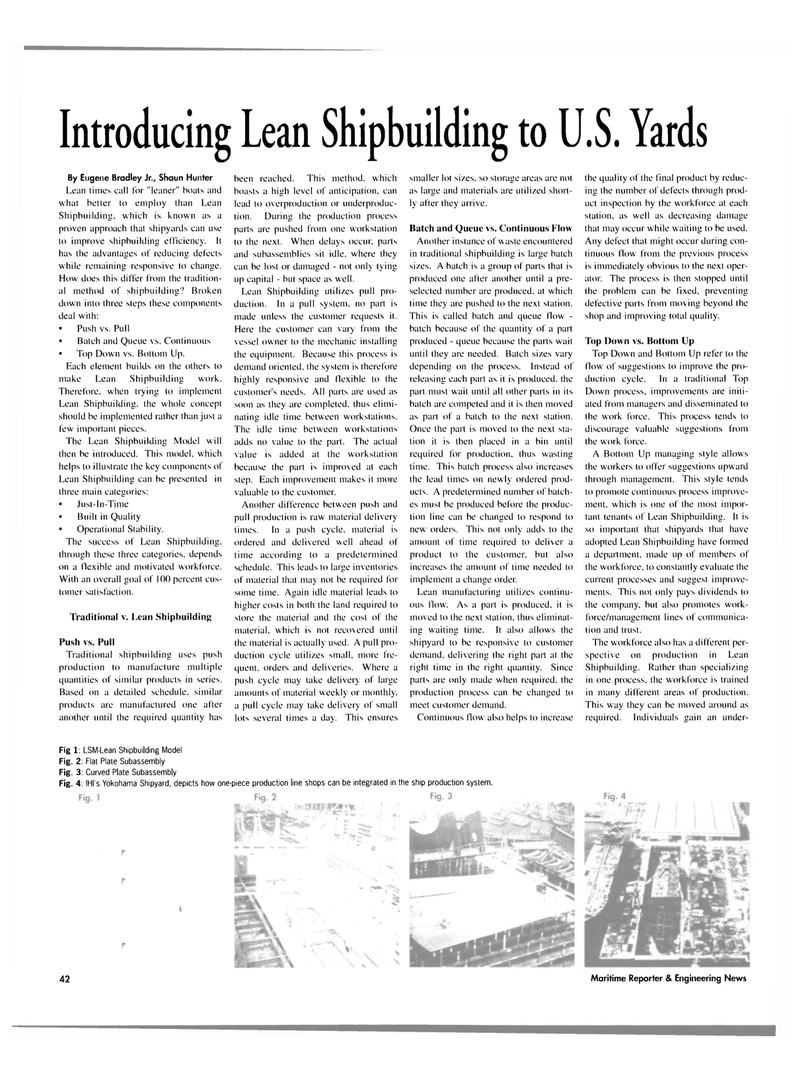
Page 43: of Maritime Reporter Magazine (November 2003)
Read this page in Pdf, Flash or Html5 edition of November 2003 Maritime Reporter Magazine
Introducing Lean Shipbuilding to U.S. Yards
By Eugene Bradley Jr., Shaun Hunter
Lean times call for "leaner" boats and what better to employ than Lean
Shipbuilding, which is known as a proven approach that shipyards can use to improve shipbuilding efficiency. It has the advantages of reducing defects while remaining responsive to change.
How does this differ from the tradition- al method of shipbuilding? Broken down into three steps these components deal with: • Push vs. Pull • Batch and Queue vs. Continuous • Top Down vs. Bottom Up.
Each element builds on the others to make Lean Shipbuilding work.
Therefore, when trying to implement
Lean Shipbuilding, the whole concept should be implemented rather than just a few important pieces.
The Lean Shipbuilding Model will then be introduced. This model, which helps to illustrate the key components of
Lean Shipbuilding can be presented in three main categories: • Just-In-Time • Built in Quality • Operational Stability.
The success of Lean Shipbuilding, through these three categories, depends on a flexible and motivated workforce.
With an overall goal of 100 percent cus- tomer satisfaction.
Traditional v. Lean Shipbuilding
Push vs. Pull
Traditional shipbuilding uses push production to manufacture multiple quantities of similar products in series.
Based on a detailed schedule, similar products are manufactured one after another until the required quantity has been reached. This method, which boasts a high level of anticipation, can lead to overproduction or underproduc- tion. During the production process parts are pushed from one workstation to the next. When delays occur, parts and subassemblies sit idle, where they can be lost or damaged - not only tying up capital - but space as well.
Lean Shipbuilding utilizes pull pro- duction. In a pull system, no part is made unless the customer requests it.
Here the customer can vary from the vessel owner to the mechanic installing the equipment. Because this process is demand oriented, the system is therefore highly responsive and flexible to the customer's needs. All parts are used as soon as they are completed, thus elimi- nating idle time between workstations.
The idle time between workstations adds no value to the part. The actual value is added at the workstation because the part is improved at each step. Each improvement makes it more valuable to the customer.
Another difference between push and pull production is raw material delivery times. In a push cycle, material is ordered and delivered well ahead of time according to a predetermined schedule. This leads to large inventories of material that may not be required for some time. Again idle material leads to higher costs in both the land required to store the material and the cost of the material, which is not recovered until the material is actually used. A pull pro- duction cycle utilizes small, more fre- quent. orders and deliveries. Where a push cycle may take delivery of large amounts of material weekly or monthly, a pull cycle may take delivery of small lots several times a day. This ensures smaller lot sizes, so storage areas are not as large and materials are utilized short- ly after they arrive.
Batch and Queue vs. Continuous Flow
Another instance of waste encountered in traditional shipbuilding is large batch sizes. A batch is a group of parts that is produced one after another until a pre- selected number are produced, at which time they are pushed to the next station.
This is called batch and queue flow - batch because of the quantity of a part produced - queue because the parts wait until they are needed. Batch sizes vary depending on the process. Instead of releasing each part as it is produced, the part must wait until all other parts in its batch are competed and it is then moved as part of a batch to the next station.
Once the part is moved to the next sta- tion it is then placed in a bin until required for production, thus wasting time. This batch process also increases the lead times on newly ordered prod- ucts. A predetermined number of batch- es must be produced before the produc- tion line can be changed to respond to new orders. This not only adds to the amount of time required to deliver a product to the customer, but also increases the amount of time needed to implement a change order.
Lean manufacturing utilizes continu- ous flow. As a part is produced, it is moved to the next station, thus eliminat- ing waiting time. It also allows the shipyard to be responsive to customer demand, delivering the right part at the right time in the right quantity. Since parts are only made when required, the production process can be changed to meet customer demand.
Continuous flow also helps to increase the quality of the final product by reduc- ing the number of defects through prod- uct inspection by the workforce at each station, as well as decreasing damage that may occur while waiting to be used.
Any defect that might occur during con- tinuous flow from the previous process is immediately obvious to the next oper- ator. The process is then stopped until the problem can be fixed, preventing defective parts from moving beyond the shop and improving total quality.
Top Down vs. Bottom Up
Top Down and Bottom Up refer to the flow of suggestions to improve the pro- duction cycle. In a traditional Top
Down process, improvements are initi- ated from managers and disseminated to the work force. This process tends to discourage valuable suggestions from the work force.
A Bottom Up managing style allows the workers to offer suggestions upward through management. This style tends to promote continuous process improve- ment. which is one of the most impor- tant tenants of Lean Shipbuilding. It is so important that shipyards that have adopted Lean Shipbuilding have formed a department, made up of members of the workforce, to constantly evaluate the current processes and suggest improve- ments. This not only pays dividends to the company, but also promotes work- force/management lines of communica- tion and trust.
The workforce also has a different per- spective on production in Lean
Shipbuilding. Rather than specializing in one process, the workforce is trained in many different areas of production.
This way they can be moved around as required. Individuals gain an under-
Fig 1: LSM-Lean Shipbuilding Model
Fig. 2: Flat Plate Subassembly
Fig. 3: Curved Plate Subassembly
Fig. 4: IHI's Yokohama Shipyard, depicts how one-piece production line shops can be integrated in the ship production system. 42 Maritime Reporter & Engineering News

 42
42

 44
44
